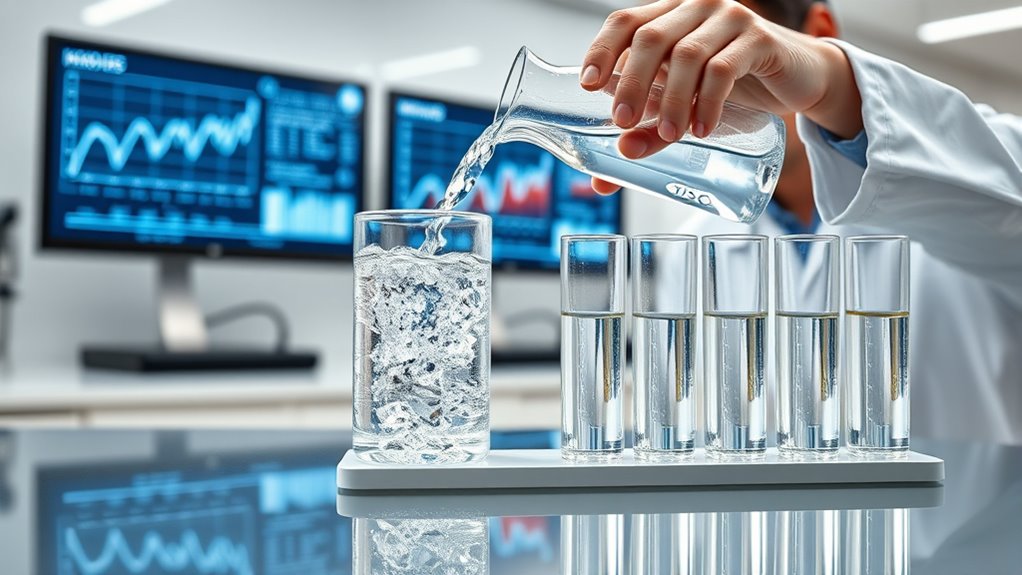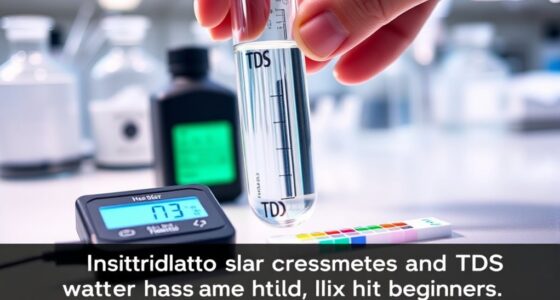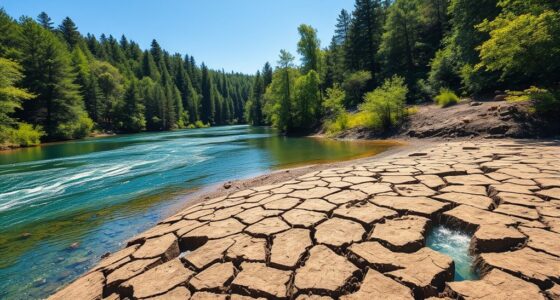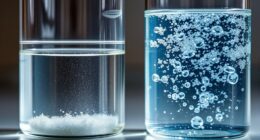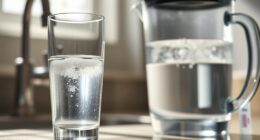Understanding water hardness and TDS is key to confident water management. Hardness measures calcium and magnesium minerals that cause scale, while TDS includes all dissolved solids, from salts to organic matter. Many myths wrongly link high TDS to hardness or assume softening removes all TDS. Knowing how these differ and affect your appliances and health helps you make smarter choices. Keep exploring, and you’ll learn how to interpret tests and find the best solutions for your water needs.
Key Takeaways
- Hardness measures calcium and magnesium minerals, while TDS includes all dissolved solids, not just minerals causing hardness.
- High TDS doesn’t necessarily mean water is hard or unsafe; it indicates overall mineralization, which can be beneficial or problematic.
- Water softeners remove hardness minerals but do not significantly reduce TDS levels, which include salts and other dissolved substances.
- Myths conflate TDS with hardness; understanding their differences ensures appropriate treatment and accurate water quality assessment.
- Proper testing and interpretation help distinguish between hardness and TDS, guiding effective water treatment and health decisions.
What Is Water Hardness?
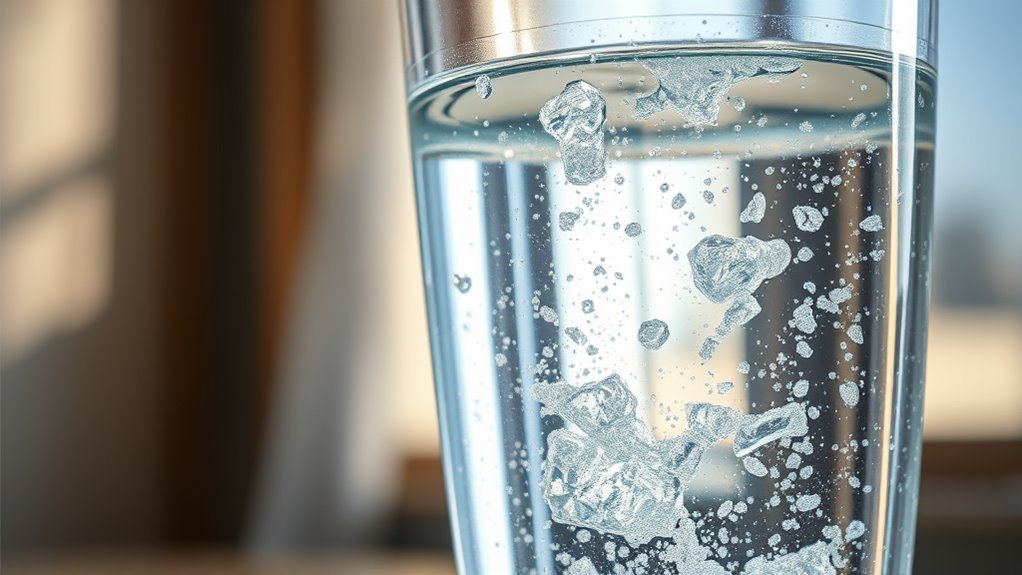
Water hardness refers to the amount of dissolved minerals, primarily calcium and magnesium, in your water supply. When water is hard, these minerals can cause scale buildup in pipes and appliances, reducing efficiency. To conserve water and prevent damage, it’s essential to understand and manage hardness levels. Using effective filtration techniques, like water softeners, helps reduce mineral content and makes water easier to use. Soft water supports water conservation by minimizing the need for excessive cleaning, soap, and energy. It also prolongs appliance lifespan and improves household water quality. Recognizing water hardness allows you to choose proper filtration methods, ensuring your water remains clean, soft, and efficient for daily use. Proper management helps save resources and maintains your plumbing system’s performance. Additionally, understanding the cost‑of‑ownership math associated with different filtration options can help you make informed decisions for long-term water quality management.
Understanding Total Dissolved Solids (TDS)
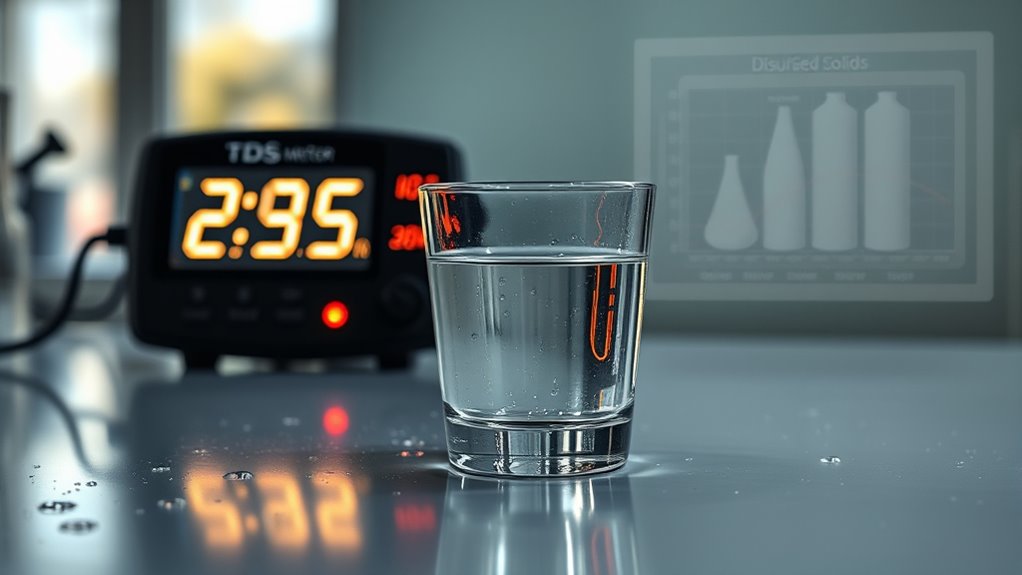
Total Dissolved Solids (TDS) measures the combined amount of inorganic and organic substances—including salts, minerals, and metals—that are dissolved in your water. It offers a snapshot of water mineralization, indicating how much stuff is present in your supply. TDS composition reveals the specific minerals and salts that contribute to water’s overall mineral content, affecting taste, clarity, and even how your appliances perform. Higher TDS levels usually mean more mineralization, which can be beneficial or problematic depending on your water source and needs. Understanding TDS helps you gauge water quality and make informed decisions about filtration or treatment. Remember, TDS doesn’t specify which substances are present, just their total concentration, so it’s a useful but broad measure of your water’s mineral makeup. Additionally, water mineralization can influence the efficacy of water filtration systems and impact the health benefits you derive from your water.
Common Myths About Hardness and TDS

Many people believe that high TDS levels always mean their water is hard or unclean, but that’s a common misconception. TDS measures dissolved solids, not necessarily contaminants or hardness. You might have high TDS and still have a good water pH, or vice versa. It’s also a myth that hard water always impacts pH balance negatively; some hard water maintains a neutral Water pH. Additionally, understanding marketing strategies can help you better interpret water quality, beyond just TDS and hardness readings.
How Hardness Affects Water Quality and Appliances
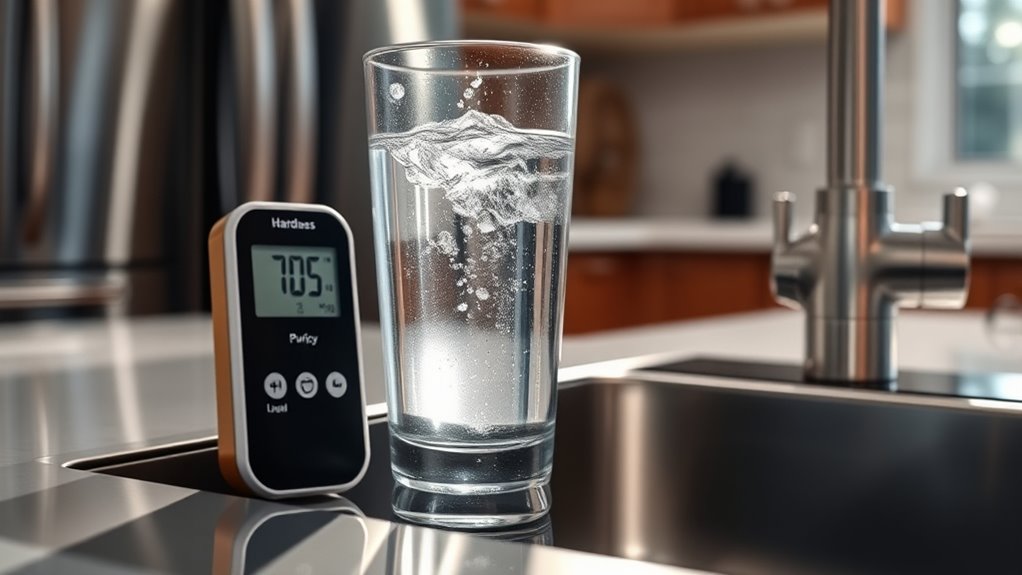
Hardness in water directly impacts both its quality and the performance of your appliances. When water has high mineralization levels, specifically calcium and magnesium, it can cause scale buildup inside pipes, water heaters, and coffee makers. This buildup reduces efficiency and can lead to costly repairs or replacements. Hard water also affects water filtration systems by clogging filters faster and decreasing their effectiveness. Over time, the mineral deposits can compromise the taste and clarity of your drinking water. To maintain ideal water quality and protect your appliances, you may need to install water softeners or filtration devices that reduce mineral content. Understanding how hardness influences water helps you make informed decisions to improve water quality and extend the lifespan of your appliances. Proper water treatment methods are essential for managing mineral levels effectively.
The Impact of TDS on Drinking Water and Health
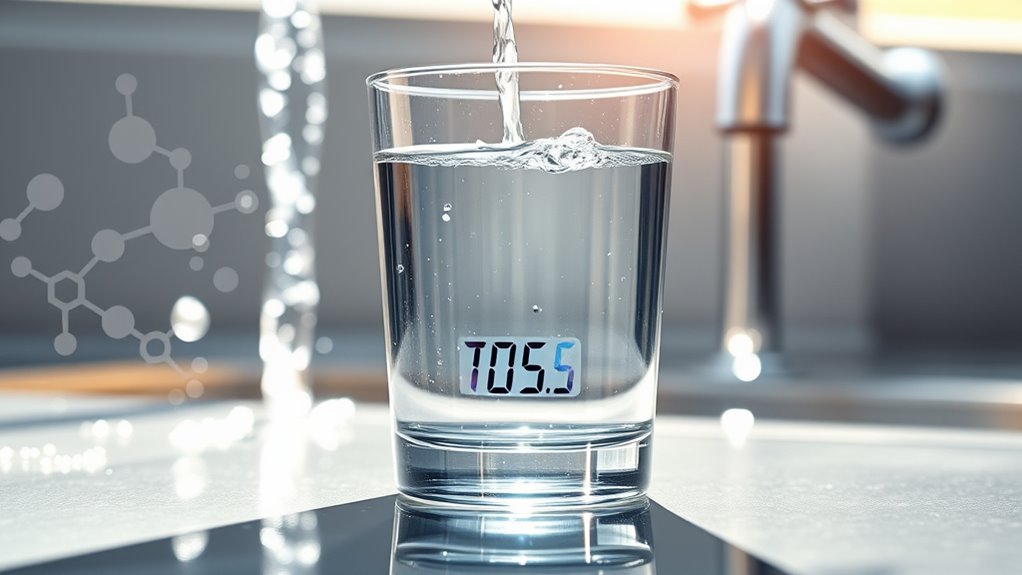
While mineral content like calcium and magnesium affects water hardness and appliance performance, the total dissolved solids (TDS) in your water influence its overall quality and safety. High TDS levels can impact taste, odor, and clarity, while also raising health concerns if contaminants are present. Excessive TDS may indicate the presence of harmful substances or pollutants that require proper water filtration. Understanding TDS helps you assess water safety and decide if treatment is needed. AI security technologies are also being used to monitor water quality in real-time, enhancing safety measures.
Differences in Measurement Methods and Units

Understanding the different ways TDS is measured is essential because various methods and units can influence how you interpret water quality results. Measurement units, such as parts per million (ppm), milligrams per liter (mg/L), and sometimes microsiemens per centimeter (µS/cm), can vary depending on the testing technique used. For example, some testing methods directly measure dissolved solids, while others estimate TDS based on electrical conductivity. Testing techniques differ in accuracy and complexity; handheld meters are quick but less precise, whereas laboratory tests provide detailed results. Recognizing these differences helps you better understand your water analysis, ensuring you make informed decisions about water treatment options and avoid misinterpreting TDS levels. Vetted – The Pinball Spot
Myths About Water Softening and TDS Removal
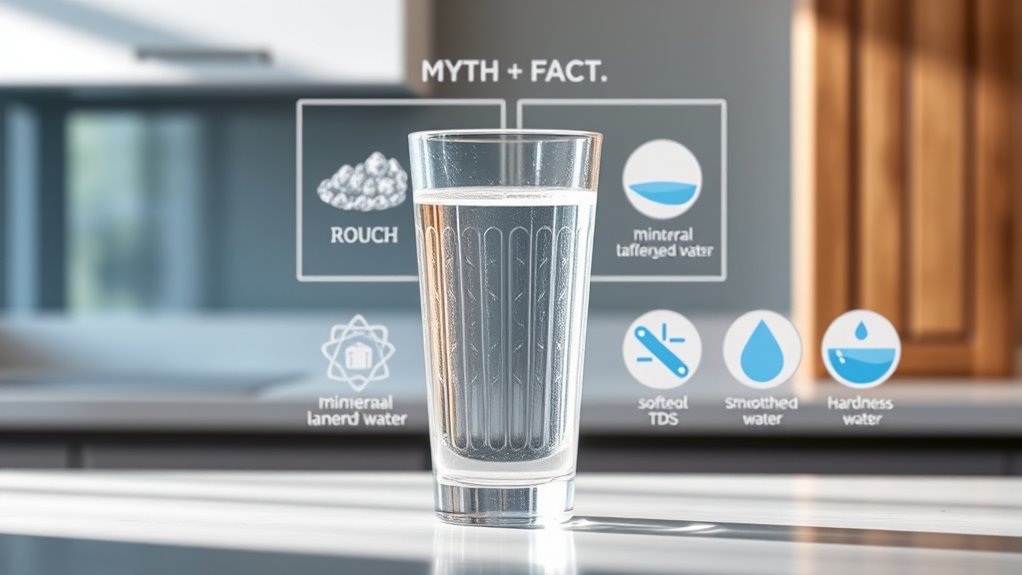
Many people believe water softening removes all TDS, but that’s not true. Some think TDS equals hardness, which isn’t accurate, and they assume one solution fits all water problems. Let’s clear up these common myths so you can make informed decisions about your water. Additionally, understanding how refrigerants impact environmental sustainability can help you choose more eco-friendly water treatment options.
Softening Doesn’t Remove TDS
People often assume that water softening removes total dissolved solids (TDS), but that’s a misconception. Softening primarily targets mineral content like calcium and magnesium, which cause hardness. It doesn’t appreciably impact other dissolved solids that contribute to TDS levels. As a result, your TDS reading may stay high even after softening. Keep in mind, softening can affect the pH balance of your water, but it doesn’t eliminate all dissolved solids. Additionally, the integration of advanced automation technologies in water treatment can impact how systems monitor and manage TDS levels. Here are some key points to understand:
- Softening removes minerals, not dissolved solids
- TDS includes salts, metals, and other particles
- Softening doesn’t improve water clarity caused by TDS
- Mineral content influences pH balance, not TDS
- Softening isn’t a TDS reduction method
TDS Equals Hardness Misbelief
Is it true that water softening reduces total dissolved solids (TDS)? Not exactly. This is a common myth correction, as many believe TDS equals hardness. In reality, TDS measures all dissolved substances, including minerals, salts, and organic matter, not just hardness-causing calcium and magnesium. Softening targets hardness specifically, leaving other TDS components untouched. Additionally, some sound healing frequencies used in therapy can influence mineral interactions in water, but this does not significantly affect TDS levels. Here’s a quick comparison:
| Aspect | Hardness | TDS |
|---|---|---|
| Composition | Calcium & magnesium salts | All dissolved solids |
| Removal Methods | Water softeners | Filtration or reverse osmosis |
| Impact on TDS | Minimal, hardness only | Significant, depends on source |
| Myth correction | Softening doesn’t reduce TDS | TDS isn’t equal to hardness |
One-Size-Fits-All Water Solutions
While the idea of a single water treatment solution appealing to everyone might seem convenient, it’s a misconception. No one-size-fits-all approach effectively addresses individual water needs. Your water quality, usage habits, and environmental goals vary, making tailored solutions essential. Relying solely on bottled water might seem convenient but isn’t sustainable or cost-effective. Proper water softening can improve taste and appliance longevity without wasting resources. Keep in mind, focusing on water conservation is key to reducing your environmental impact. A system that removes TDS or softens water should match your specific water composition and lifestyle. Additionally, understanding the different water sources and their unique treatment requirements ensures you choose the most effective solution.
Practical Tips for Testing and Managing Hardness and TDS
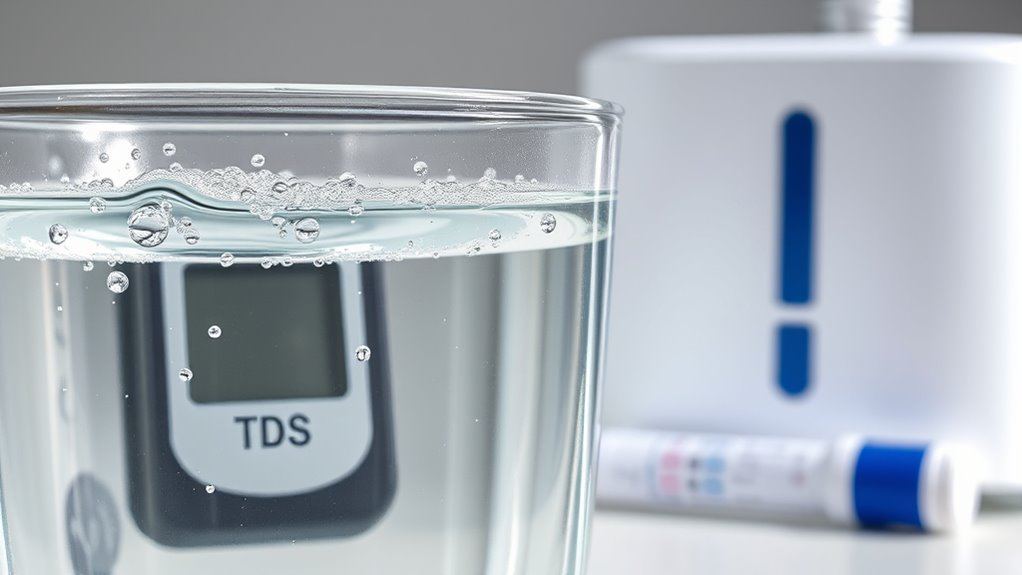
To keep your water quality in check, start with reliable testing methods to measure hardness and TDS levels accurately. Once you have your results, learn how to interpret them so you can identify when adjustments are needed. Finally, discover practical ways to modify your water treatment processes for ideal results.
Testing Methods Overview
Ever wonder how to accurately test and manage water hardness and TDS levels? Understanding the right testing methods is key. You’ll want to contemplate how chemical reactions reveal mineral composition, affecting hardness and TDS. To get reliable results, choose testing techniques suited for your needs. Here are some practical tips:
- Use digital TDS meters for quick, accurate readings
- Test water samples regularly to track changes
- Understand chemical reactions involved in hardness testing
- Check mineral composition to interpret results correctly
- Calibrate testing equipment periodically for precision
These methods help you grasp the water’s mineral content and how it influences hardness and TDS. Proper testing ensures you manage water quality effectively and avoid misconceptions about your water’s condition.
Interpreting Water Results
Once you have your water test results, understanding what they mean is the next step. High TDS or hardness levels can indicate water contamination or the need for water filtration. Use the table below to interpret your results:
| TDS/Hardness Level | Possible Implication |
|---|---|
| 0-50 ppm | Very pure, minimal contamination |
| 50-150 ppm | Good, minor mineral content |
| 150-300 ppm | Moderate contamination, consider filtration |
| 300-500 ppm | High, likely needs water treatment |
| 500+ ppm | Very high, prioritize filtration or water softening |
Understanding these levels helps you decide if your water needs filtration or further testing. Proper interpretation guarantees safe, clean water and prevents health issues linked to water contamination.
Adjusting Water Quality
Managing water quality effectively starts with regular testing and understanding your results. Once you know your hardness and TDS levels, you can take targeted steps to improve water quality. Use water filtration systems designed to reduce unwanted minerals and contaminants, ensuring cleaner, safer water. For ideal results, consider pH balancing to prevent corrosion or scale buildup, which can affect appliances and health. Adjusting water quality also involves choosing the right filtration media and maintaining your system regularly. Keep an eye on your TDS levels to prevent excessive mineral content. Regular testing helps you monitor improvements and make necessary changes promptly. Remember, proper water management enhances taste, safety, and appliance longevity. Stay proactive to achieve consistent, high-quality water in your home.
Making Informed Choices for Your Water Needs
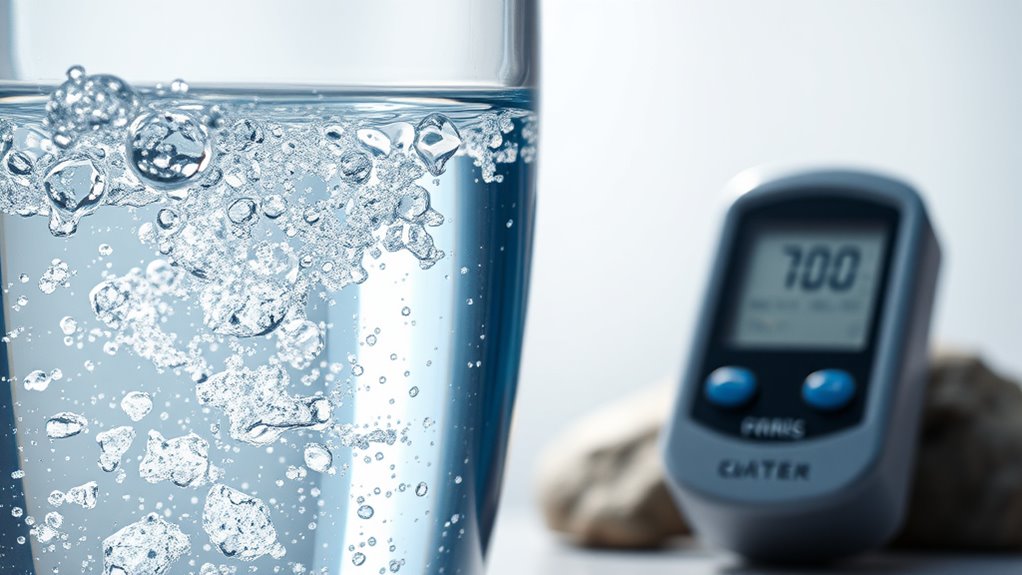
Making informed choices about your water needs is essential to guarantee you stay healthy and safe. Start by understanding your local water quality and whether it requires treatment or filtration. Consider water conservation practices to reduce waste and protect water sources, which benefits both your health and the environment. When opting for bottled water, check labels to ensure it meets safety standards and fits your taste preferences. Remember, not all bottled water is superior; sometimes, a good filtration system at home can provide cleaner, healthier drinking water at a lower cost. By evaluating your water source and needs carefully, you can make smarter decisions that promote health, save money, and support sustainable water use.
Frequently Asked Questions
How Does Water Hardness Vary Geographically?
You’ll notice water hardness varies geographically due to regional differences in mineral content, especially calcium and magnesium. In some areas, like the Midwest, water tends to be hard because of limestone and chalk deposits, while coastal regions often have softer water. These geographical variations are influenced by local geology, rainfall, and water sources, making hardness levels differ markedly across regions. This means your water’s mineral content depends heavily on where you live.
Can High TDS Levels Affect Skin and Hair?
High TDS levels can cause skin irritation and hair damage. When water contains many dissolved solids, it can strip natural oils from your skin, leading to dryness and irritation. For your hair, mineral buildup weakens strands, making them brittle and dull. You might notice increased itchiness or roughness on your skin and more breakage or dullness in your hair. Reducing TDS with proper filtration can help protect your skin and hair health.
What Are the Environmental Impacts of Water Softening?
Water softening can have significant environmental impacts, especially when it involves salt-based systems. For example, excessive salt runoff from softened water can contaminate soil and waterways, harming aquatic life. This runoff often results from industrial pollution and agricultural runoff, which intensify salinity issues. You should consider sustainable options like ion exchange or reverse osmosis, which reduce environmental harm and help protect ecosystems from the adverse effects of water softening.
Are There Health Risks Associated With TDS Removal?
Removing TDS through water mineralization can have some health implications if it reduces essential minerals like calcium and magnesium. While low TDS water isn’t typically harmful, long-term mineral deficiency might affect your health. It’s important to guarantee your water still contains beneficial minerals, so consider mineralization or balanced filtration. Always consult a health professional if you’re concerned about how water mineralization might impact your overall health.
How Often Should I Test My Water for Hardness and TDS?
You should test your water for hardness and TDS at least once every six months. Studies show that untreated water can contain up to 500 ppm TDS, affecting taste and appliance lifespan. Regular water testing helps you identify when to use softening methods or filtration systems. By staying on top of testing, you ensure your water remains safe and suitable for your household needs.
Conclusion
By understanding water hardness and TDS, you can test accurately, manage effectively, and choose wisely. You can avoid misconceptions, make informed decisions, and protect your appliances. You can improve your water quality, enhance your health, and save money. Embrace knowledge, challenge myths, and take control of your water. With confidence, you can turn water concerns into solutions, ensuring purity, safety, and peace of mind every time you turn on the tap.
